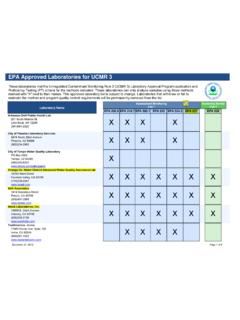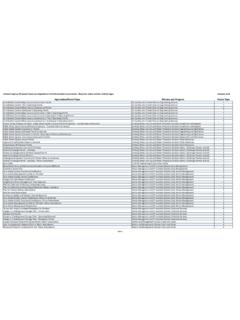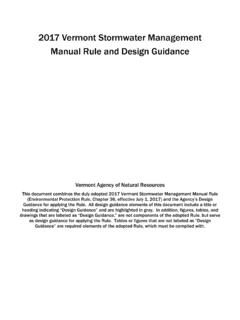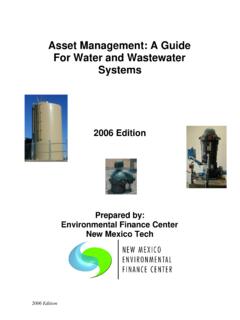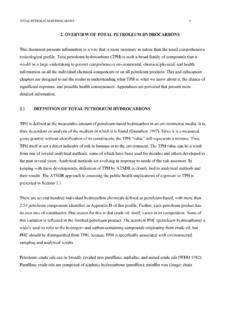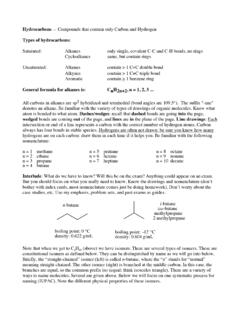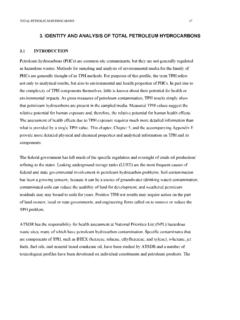Transcription of SOIL SCREENING LEVELS FOR TOTAL PETROLEU M …
1 Regional Offices Essex Johnsbury AGENCY OF NATURAL RESOURCES SOIL SCREENING LEVELS FOR TOTAL petroleum HYDROCARBONS Last Update: May 31, 2017 Introduction This document provides clarification about soil SCREENING LEVELS for TOTAL petroleum Hydrocarbons (TPH) and the appropriate analytical methods. This document also summarizes conditions when TPH testing is required as part of the investigation and remediation of contaminated properties. Background Prior to the April 2012 Investigation and Remediation of Contaminated Properties Procedure (IROCP), the Vermont Department of Environmental Conservation (VT DEC) used soil SCREENING values for TPH based on a 1992 memorandum from VT DEC to the Vermont Department of Health (VDH), which were 200 mg/kg and 1,000 mg/kg for residential and industrial soil, respectively.
2 In November 2013, the EPA updated the regional SCREENING values to include six fractions of TPH based on updated information. However, the carbon ranges of these six fractions did not directly correspond with the analyses typically used to quantify TPH , that is, EPA Method 8015 diesel range organics (DRO) and EPA Method 8015 gasoline range organics (GRO). Furthermore, the regional SCREENING LEVELS (RSLs) that EPA provided in their November 2013 table for the six TPH fractions (low, medium, and high aliphatics and the low, medium, and high aromatics) were calculated using cancer toxicity values. Because the new EPA values for TPH were based on more current information than the Vermont 1992 TPH values, the table in the IROCP in early 2014 was changed on the Sites Management Section (SMS) website to reflect the November 2013 EPA s RSLs for the six TPH fractions.
3 However, in May 2014, shortly after the Vermont SSV table in Appendix A of the IROCP was revised, EPA again revised the RSLs for TPH. The RSLs were re-calculated without using the cancer toxicity values. The EPA s reason for the revision was that most carcinogens within the TPH carbon range are listed separately on the RSL table and the combining of cancer risk for TPH and the individual constituents would be overly protective. Below is a link to the EPA website that provides more background. #FAQ53 The SSV table in the Investigation and Remediation of Contaminated Properties Rule is a compilation of SCREENING values, consisting of values provided by the VDH and EPA.
4 In cases where there is not a VDH value, then the EPA s regional SCREENING values for target cancer risk (TR) of 10-6 and target hazard quotient (THQ) of 1 are to be used. State of Vermont Department of Environmental Conservation Waste Management & Prevention Division 1 National Life Drive Davis 1 Montpelier, VT 05620-3704 (802) 828-1138 TPH Soil SCREENING May 31, 2017 Page 2 of 3 TPH concentration can be used as an indicator of petroleum contamination, however compound specific analysis is used for regulatory purposes where petroleum contamination is suspected. The VT DEC believes that the current EPA RSLs (calculated without using cancer toxicity) are the best information available related to TPH SCREENING values at this time.
5 The EPA RSLs are the basis for the Vermont TPH values provided below. Vermont Soil SCREENING Values and Analytical Methods VT Soil SCREENING Value for TPH TPH-GRO (C6-C10) TPH-DRO (C11-C28) Residential Soils 82 mg/kg* 96 mg/kg* Industrial Soils 420 mg/kg* 440 mg/kg* *These values are based on the EPA RSLs (latest update January 2015). Because the region SCREENING LEVELS are updated regularly, the EPA RSL website should be checked to ensure that the most updated values are being used. From the perspective of the VT DEC, TPH analysis in soils is primarily used as a SCREENING method and it is not a stand-alone analysis. The specific TPH analysis (GRO or DRO) will depend on site use, history, and conditions.
6 When the source of petroleum contamination is unknown, or both gasoline and diesel range (or higher) compounds are suspected, then both GRO and DRO TPH analyses should be performed. Any TPH analyses must be accompanied by the applicable compound-specific analysis. Any alternative evaluation must be approved by the SMS prior to its implementation. In determining the above values, it was assumed that the EPA Method 8015 TPH-GRO results roughly correspond to the low carbon fractions, and EPA Method 8015 TPH-DRO roughly correspond to the medium and high carbon fractions. The lowest EPA RSL among the low fractions was used for the TPH-GRO values, and the lowest EPA RSL value among the four remaining fractions was used for the TPH-DRO.
7 This approach is considered conservative and protective of human health and the environment. Based on the current values in the EPA RSL tables, the lowest EPA RSL value for the low carbon fractions was the low aromatics, and the lowest EPA RSL values the middle to high fraction was the middle aliphatics. As stated in the Table above, the EPA RSL tables must be checked to ensure the most updated values are being used. In other words, the tables must be checked to ensure the lower of the two low TPH fractions is being used for the TPH-GRO fraction and the lowest of the four medium to high fractions is being used for the TPH-DRO fraction.
8 In most case, the VT DEC does not believe that TPH analyses warrant the expense and effort for laboratories to modify their analytical methods to differentiate the six TPH fractions identified in the EPA RSL tables. However, in cases where the TPH level is less than twice the applicable Vermont SSV for TPH (see table above), an alternative analysis which differentiates the TPH into the six TPH fractions, such as volatile petroleum hydrocarbon (VPH) for the volatile TPH fractions and Extractable petroleum hydrocarbon (EPH) for the medium to high TPH fractions, can be used so that a comparison can be made with the specific TPH fractions in the EPA RSL table.
9 TPH Soil SCREENING May 31, 2017 Page 3 of 3 Additional Info Why is TPH soil testing needed, especially if compound specific testing is required anyways? TPH are various mixtures of hundreds of petroleum hydrocarbons that vary in size (six to more than 35 carbon atoms in a molecule) and structure (alkanes, alkenes, cycloalkanes, and aromatics). Compound-specific testing does not capture all the petroleum hydrocarbons that can be present, and toxicity values have only been developed for a small numbers of the compounds found in petroleum hydrocarbons. TPH testing provides a means to quantify the magnitude (in relative terms) of petroleum contamination that remains in the soil.
10 Several states, such as Oklahoma, Oregon, and Maine, have fact sheets or reports that explain further why they require TPH testing. When is TPH Testing Applicable? TPH analysis is considered to be primarily a SCREENING tool, and is not a stand-alone analysis. In general, TPH testing is used to determine if petroleum contamination (gasoline-range, diesel-range, or both) is present is soils that could pose a direct contact risk. Compound specific analysis for petroleum using EPA Methods 8021, 8260, and/or 8270 should be performed to look for target hydrocarbon analytes. TPH testing is not required unless requested by the SMS project manager.

